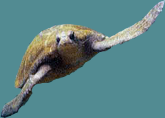Floating Island Proposal
In accordance with the effort to reduce the impact of humans and their activities on the ecosystem of the Galapagos Islands the member of the ecovillage group have decided to consolidate the three existing airports on the Galapagos Islands to a single off-shore airport utilizing technology which has been developed by Float Inc. The sites of the three existing airports are to be demolished and replanted with endemic species found in the areas surrounding the sites.
The off-shore airport is to be located at one of three sites with in the waters of the Galapagos. The conditions for the placement of the airport are as follows:
- The site is of a sufficient depth, where no ocean floor flora or fauna will be affected.
- The site is located at distance from shore where it easily and quickly accessed by boat from the majority of the islands but is at a distance where its impact on the coastline of the islands in closest proximity is negligible.
The off-shore platform will also be utilized as a fully operational dock for larger ships which usually docked at any of the current ports in the Galapagos.
The platform will also be the permanent tourist residence on the islands.
The platform itself will be designed to be as self sufficient as possible with its own power-plant, waste disposal, and water resources.
Power
There are many proposals for generation. Currently the two leading proposals are the use of Hydrogen fuel cells or the utilization of an energy scheme called “Energy Island” which being developed by Solar Energy Ltd. The method consists of combing solar, wind, wave and sea current energy gathering technologies on a single floating platform.
Waste Disposal
The current proposal for waste treatment and disposal is the conversion of wastes to bio gas and bio diesel.
Water
Desalination is the current proposal for water gathering.
[top]
Justification
The goal of this project is to minimize the impact of our presence and activities on the islands in order to preserve the endemic species and the condition under which they arose. In order to carry out this mandate it is essential that large scale activities such as shipping and mass transport be isolated from the islands. The only way to do this and still maintain a degree of accessibility by mass transport is to have an area off-shore where all the fore-mentioned activities can take place but not effect the ecosystem of the islands themselves. As such it was decided that an off-shore platform should be constructed to achieve this goal.
Having an off-shore platform as described in the proposal will also allow us to better deal with the problem of introduced species to the islands as all incoming traffic will have to first stop at the off-shore platform and be passed before they are allowed to stop at any island. This proposal also gives us a way to allow larger visitor craft to access the island without actually do harm to the environment. As such this will create more revenue for the inhabitants.
This proposed plan of action is much superior to an alternate plan of just consolidating all activities to one island. Such a plan would only serve to isolate an island form the rest of the archipelago and would further damage the ecosystem of that specific island.
[top]
Technology
The proposed platform utilizes technology known as Pneumatically Stabilized Platform technology or PSP. This technology is currently being developed by a San Diego based company called Float Inc.
The platform utilizes indirect displacement, in which the platform rests on trapped air that displaces the water. The primary buoyancy force is provided by air pressure acting on the underside of the deck. The PSP is a unique type of pneumatic platform. The platform is composed of a number of cylindrical shaped components packed together in a rectangular pattern to form a module. Each cylinder is sealed at the top, open to the ocean at its base, and contains air at a pressure slightly above atmospheric pressure (
http://www.floatinc.com/)
[top]
Dimensions
Surface Area
Runway: 9000’ x 500’
Dock: 1400’ x 1400’ (approximately)
Terminal
Harbor master: 1500’ x 1400’
Living Area
Utilities – Water, Power, Waste Management
Total Surface area: 8560000sq.ft (196.5 acres)
Cost per acre: $5,000,000
Total Cost: $982,500,000
[top]
Copyright! All rights reserved.
Webmasters


